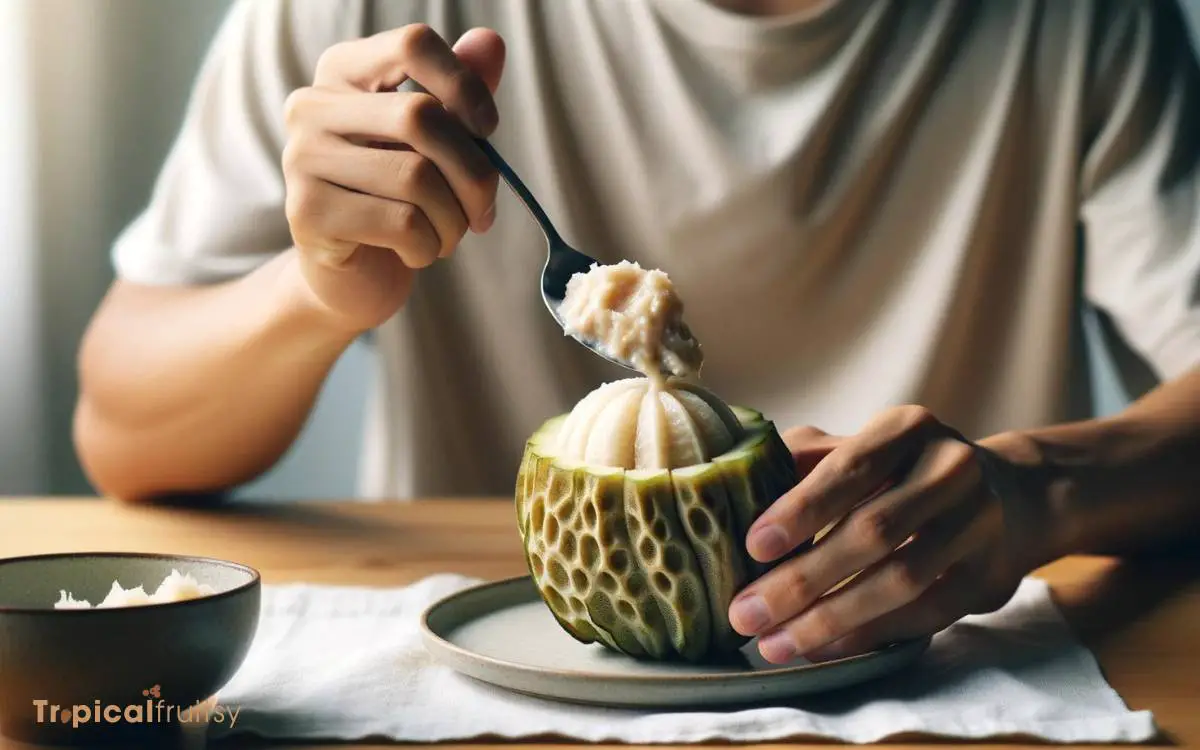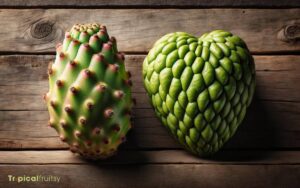How to Eat a Cherimoya? 8 Easy Steps!
To eat a cherimoya, also known as custard apple, follow these steps: cut the fruit in half, remove the seeds, and scoop out the creamy flesh with a spoon. Enjoy it raw, in fruit salads, or use it in desserts like mousses and ice creams.
Cherimoya is a tropical fruit known for its sweet taste that’s often described as a blend of other fruits like banana, pineapple, and strawberry. Its texture is similar to that of custard, hence the nickname “custard apple.”
Here’s a step-by-step guide on how to eat a cherimoya:
Remember, cherimoya is best enjoyed when it’s fully ripe, which you can determine by gently pressing the skin. It should yield slightly under pressure, much like a ripe avocado.
Cherimoya’s delightful flavor and creamy texture make it a unique and exotic treat to enjoy on its own or incorporated into a variety of sweet dishes.

Key Takeaway
Store uneaten cherimoya in an airtight container in the refrigerator for up to 3 days or puree and freeze it for up to 4 months.
It can also be used as a topping for yogurt or cereal, or blended into smoothies for a nutritious beverage.
Step 1: Selecting the Right Cherimoya
One must choose a cherimoya that’s firm yet yields slightly to pressure, signaling ripeness and a sweet, custardy flavor within.
Selecting the right cherimoya is crucial not only for enjoying its unique taste but also for maximizing its health benefits.
This fruit is packed with vitamins C and B6, essential for immune system support and metabolic function. It’s also a good source of dietary fiber, contributing to digestive health.
The presence of antioxidants in cherimoya helps combat free radicals, which are linked to chronic diseases. Potassium, an important mineral found in cherimoyas, aids in maintaining healthy blood pressure levels.
Understanding how to discern the optimal ripeness of a cherimoya enhances one’s ability to enjoy these health benefits fully.
Step 2: Understanding Ripeness Cues
Recognition of a cherimoya’s ripeness is key to ensuring the fruit’s peak flavor and nutritional value. A ripe cherimoya not only offers the best taste but also contains optimal levels of vitamins and minerals.
To determine when a cherimoya is ready to eat, look for these cues:
- The skin turns from green to a yellowish hue.
- Gentle pressure yields slight softness, similar to a ripe avocado.
- A fragrant, tropical scent emanates from the fruit.
- The stem end gives slightly under pressure.
These signals indicate that the cherimoya is at its nutritional prime, ready to deliver its full health benefits.
With the fruit’s readiness confirmed, it’s time to move on to washing and preparing the cherimoya for consumption.
Step 3: Washing and Preparing
Before enjoying the delicate flavors of a ripe cherimoya, it’s essential to always wash and prepare the fruit properly.
This initial step is crucial not only for hygiene but also to minimize the ingestion of any pesticides or contaminants that may be present on the skin. One should gently rinse the cherimoya under cold water and pat it dry with a clean towel.
Next, slice the fruit in half to expose the creamy interior. The black seeds within are inedible and should be removed. They’re easily distinguishable and can be scooped out with a spoon.
Once the seeds are discarded, the cherimoya’s flesh can be cubed or scooped out to enjoy. It’s important to note that the skin isn’t meant to be eaten, so separating the flesh from it’s a must.
Step 4: Proper Cutting Technique
Slicing the cherimoya properly will ensure that you can remove the seeds and enjoy the fruit’s flesh with ease.
The creamy texture of this fruit is packed with vitamins, minerals, and antioxidants, which are best preserved by careful cutting.
Here’s how to do it:
- Place the cherimoya on a clean cutting surface.
- Using a sharp knife, cut the fruit in half lengthwise.
- Gently pull apart the two halves to expose the creamy interior.
- Remove the black seeds, as they aren’t edible.
By cutting the cherimoya correctly, you’ll minimize waste and maximize your intake of its beneficial nutrients. The seeds are easily distinguishable from the nutritious flesh, making them simple to discard.
Enjoy the cherimoya’s healthful rewards with this straightforward method.
Step 5: Safe Seed Removal
When enjoying a cherimoya, it’s crucial to remove the seeds, as they’re toxic when ingested.
The proper cutting technique ensures that one can easily identify and extract the seeds without compromising the fruit’s flesh.
This step not only prevents potential health risks but also allows for the full enjoyment of the cherimoya’s nutrient-rich benefits.
Avoiding Toxic Seeds
Cherimoya seeds contain toxic compounds, so it’s crucial to remove them carefully before consumption.
The seeds can cause severe health issues if ingested, due to the presence of toxic alkaloids such as annonacin. Therefore, one must handle them with care to prevent accidental ingestion.
Here’s how to safely remove cherimoya seeds:
- Cut the cherimoya into sections, exposing the seeds.
- Use a spoon or your fingers to gently scoop out the seeds.
- Dispose of the seeds immediately to avoid confusion.
- Ensure no seeds or fragments remain in the flesh.
Proper Cutting Technique
To ensure safe seed removal, first make a lengthwise incision in the cherimoya with a sharp knife. This cut should be just deep enough to pierce the skin but not so deep as to slice through the large black seeds, which can be toxic.
Twist the fruit gently to open it into two halves. Carefully inspect each half for seeds, which can be easily scooped out with a spoon.
Here’s a quick guide on the steps:
| Step | Description | Benefit |
|---|---|---|
| 1. Cut | Make a lengthwise incision | Avoids cutting seeds |
| 2. Twist | Open the fruit into halves | Exposes seeds for removal |
| 3. Inspect | Look for black seeds | Prevents accidental ingestion |
| 4. Scoop | Use a spoon to remove seeds | Keeps the flesh intact |
Step 6: Best Ways to Enjoy
Cherimoya’s creamy texture and rich nutrients make it a versatile fruit for various culinary explorations.
Savoring it raw ensures full access to its vitamin C and fiber content, while blending it into a smoothie can be a refreshing way to enjoy its antioxidants.
For those with a sweet tooth, incorporating cherimoya into baked desserts offers a nutritious twist to traditional recipes.
Raw Fruit Sampling
Sampling the creamy flesh of a cherimoya raw is the quintessential way to savor its unique blend of tropical flavors. The fruit isn’t only delicious but also packed with essential nutrients that contribute to a healthy diet.
Here’s how to enjoy the cherimoya at its best:
- Chill the Fruit: Refrigerate the cherimoya until it’s cold. This enhances its naturally sweet taste.
- Cut and Scoop: Slice the fruit in half and use a spoon to scoop out the flesh, avoiding the seeds.
- Blend into Smoothies: Combine with other fruits for a nutrient-rich drink.
- Pair with Citrus: Add a squeeze of lime or lemon to accentuate the cherimoya’s flavors and increase the absorption of its vitamin C.
Enjoying cherimoya in these ways allows one to fully experience its health benefits.
Cherimoya Smoothie Recipes
Incorporating cherimoya into smoothies is a fantastic way to enjoy its creamy texture and boost your nutrient intake. This exotic fruit, packed with vitamins C and B6, along with fiber and antioxidants, makes for an ideal smoothie ingredient.
Crafting a cherimoya smoothie not only elevates your breakfast or snack time but also enhances your overall health profile.
To highlight the nutritional benefits of including cherimoya in your smoothies, consider the following table:
| Nutrient | Benefit | Smoothie Ingredient |
|---|---|---|
| Vitamin C | Supports immune system | Cherimoya |
| Fiber | Aids digestive health | Banana |
| Vitamin B6 | Promotes brain health | Spinach |
| Potassium | Regulates blood pressure | Avocado |
| Antioxidants | Combats oxidative stress | Berries |
Baked Dessert Incorporation
Beyond blending into smoothies, cherimoya can elevate baked desserts with its custard-like sweetness.
When incorporated into baked goods, cherimoya not only adds a tropical flavor but also contributes beneficial nutrients like vitamin C, fiber, and antioxidants.
Here are the best ways to enjoy cherimoya in baked desserts:
- Cherimoya Cheesecake: Purée the fruit and swirl into cheesecake batter before baking, offering a creamy texture and a boost of vitamin B6, which supports metabolism.
- Custard Tarts: Spoon fresh or lightly cooked cherimoya into pre-baked tart shells and bake until set for a dessert rich in dietary fiber.
- Muffins: Fold diced cherimoya into muffin batter, providing moisture and a natural sweetness, reducing the need for added sugars.
- Crumble Topping: Combine cherimoya with other fruits under a crumble topping for a dessert high in vitamin C and antioxidants.
Step 7: Storing Leftover Fruit
Refrigerate any uneaten cherimoya in an airtight container to maintain its freshness for up to three days. It’s crucial to prevent moisture loss, which can compromise the fruit’s nutrient content and texture.
Cherimoyas are rich in fiber, vitamin C, and antioxidants. Proper storage helps to preserve these vital nutrients.
Here’s a table to guide you on storing leftover cherimoya:
| Storage Method | Duration | Tips |
|---|---|---|
| Refrigeration | Up to 3 days | Use an airtight container |
| Freezing | Up to 4 months | Puree first; add lemon to prevent browning |
| Room Temperature | 1-2 days | Keep away from direct sunlight |
Always check the fruit for any signs of spoilage before consumption. Enjoying cherimoya at its best means savoring it not just for its flavor but also for its health benefits.
Step 8: Health Benefits Explained
Cherimoyas offer a wealth of health benefits, including a significant boost to the immune system due to their high vitamin C content. This exotic fruit isn’t only delicious but also packs an impressive nutritional punch.
To paint a picture of its advantages:
- Rich in Antioxidants: Cherimoyas contain antioxidants like vitamin C and flavonoids, which combat oxidative stress and may reduce the risk of chronic diseases.
- Fiber-Filled: With a good amount of dietary fiber, cherimoyas promote digestive health and may help in maintaining a healthy weight.
- Heart Health: Potassium in cherimoyas contributes to heart health by regulating blood pressure levels.
- Low in Calories: Despite their creamy texture, cherimoyas are relatively low in calories, making them a guilt-free treat for those monitoring their caloric intake.
How to Prepare a Cherimoya
Preparing a cherimoya is straightforward and allows you to enjoy its unique flavor and creamy texture.
Here’s a simple guide on how to prepare a cherimoya:
- Selecting a Ripe Cherimoya: First, choose a cherimoya that is ripe and ready to eat. A ripe cherimoya will be slightly soft to the touch, similar to a ripe avocado. The skin may turn a darker green or even slightly brown, and it may give off a pleasant, fruity aroma.
- Washing: Wash the cherimoya under cool running water to remove any dirt or residue on the skin. Pat it dry with a clean towel.
- Cutting: Using a sharp knife, cut the cherimoya in half lengthwise. The fruit has a custard-like texture, so it should cut easily.
- Removing the Seeds: Scoop out the black seeds from each half with a spoon. Be careful not to eat the seeds, as they are toxic.
- Eating: The white flesh can be scooped out with a spoon and eaten directly. It’s creamy and sweet, often compared to a blend of banana, pineapple, and strawberry flavors.
Alternative Ways to Enjoy Cherimoya:
- Cubed or Sliced: You can cut the flesh into cubes or slices, removing the seeds, and use it in fruit salads or as a topping for desserts.
- Smoothies: Blend the scooped-out flesh with other fruits and ingredients to make a delicious smoothie.
- Desserts: The creamy texture of cherimoya makes it a great ingredient for custards, ice creams, and other dessert recipes.
When handling cherimoya, keep in mind that the seeds and skin should not be eaten. The flesh is the only edible part of the fruit.
Enjoying cherimoya is a great way to add a tropical flair to your diet!
Conclusion
In the orchard of well-being, cherimoya is the hidden gem, its seeds of caution nestled within creamy flesh.
Savoring this fruit is like unlocking nature’s own medicine chest, brimming with nutrients. As one slices through its green exterior, a treasure trove of vitamins and fiber reveals itself.
With each careful bite, the body celebrates the harvest of health, ensuring that the cherimoya’s sweet, custard-like bounty is both a delight and a guardian of vitality.






